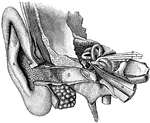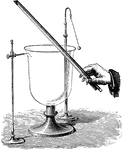Clipart tagged: ‘sense’

Epithelium
"Portion of epithelium from the tentacle of an Actinian, showing three supporting cells and one sense…

General view of organ of hearing
"A, pinna; B, cavity of the concha, showing the openings of a great number of sebaceous…

Sense of Smell
The sense of smell is closely allied with the sense of taste. The organs of the sense of smell are simple…

Sense of Taste
The sense of taste enables us to test in some degree the chemical constitution of substances we take…

Tone
An example of how to produce a tone. This illustration shows one end of a string fixed to a hook and…

Tone
"A glass bell is fixed to stand, and beside it is a stand carrying a small ivory ball. This is so arranged…

Tone
"If a light strip of steel is firmly gripped at one end in a vice and the other end plucked aside, it…